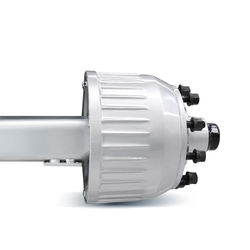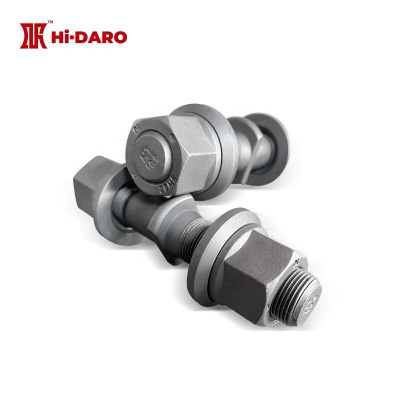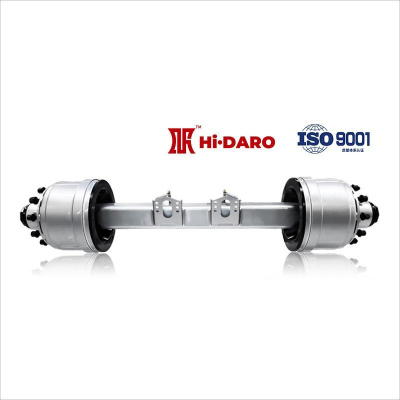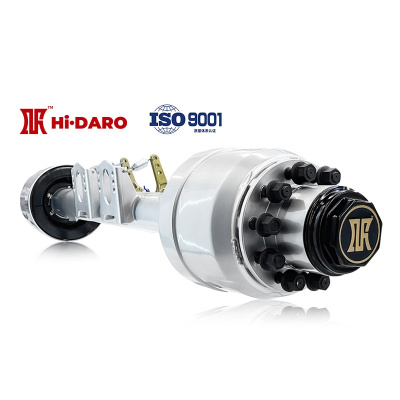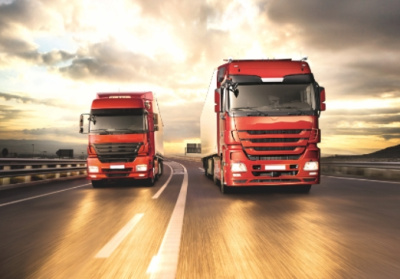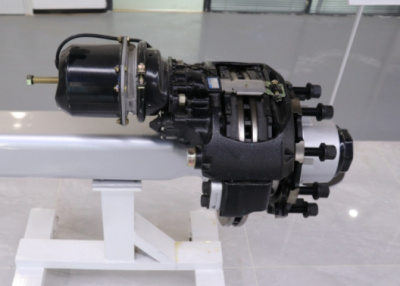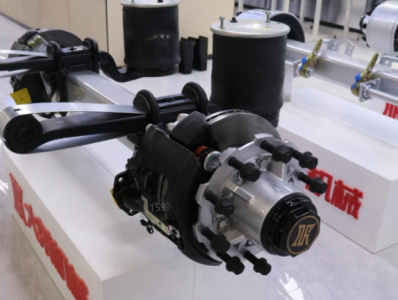What are the three parts of a vehicle suspension?
The vehicle suspension is a device installed between the vehicle frame and the axle of the trailer to act as a force-transmitting connection. It can not only transmit the force and torque between the wheel and the vehicle frame, but also buffer the impact of the uneven road surface on the vehicle body. , to reduce vibration and ensure the ride comfort of the vehicle.
In general, the suspension is mainly composed of three parts: elastic elements, guides and shock absorbers. Of course, some suspensions with complex structures will also have buffer blocks, stabilizer bars, etc.

1. Elastic elements
It is mainly used to bear and transmit vertical loads and buffer the impact from the road surface. Generally, it can be divided into leaf springs, air springs, coil springs, torsion bar springs, etc.
1. Leaf spring
Leaf spring is the most commonly used elastic element on trailer suspension at present. It can be divided into multi-leaf spring and less-leaf spring. At the same time, it can also serve as a guide device and has a certain shock absorption effect.
The advantages of leaf springs are simple structure, reliable strength, low cost, and convenient maintenance; the disadvantages are high weight, poor comfort, and long longitudinal dimensions, which are not conducive to shortening the front suspension and rear suspension of the vehicle. Pins are prone to wear and tear.
2. Air spring
The main elastic element used in the air suspension injects compressed air into a sealed container, and realizes the elastic effect through the compressibility of the gas. According to the structure of the airbag, it can be divided into three types: bladder type, membrane type and composite type.
The advantage of the air spring is that it is light in weight, conforms to the trend of lightweight, has excellent nonlinear elastic characteristics, good shock absorption performance, and strong protection ability for goods. After adding a height adjustment device, it can realize single or multi-bridge lifting; the disadvantage is that The structure is relatively complex, the cost is high, the strength is poor, and the maintenance is cumbersome.
3. Coil spring
Coil springs are generally used in independent suspensions, and are currently the standard equipment for most off-road four-wheel drive suspensions. They are also used in non-independent rear wheel suspensions of some high-performance cars.
Its advantage is that it can provide a greater wheel axle height difference, so that the loaded wheel can achieve a greater up and down stroke, light weight, small space occupation, no lubrication during use, no fear of mud, and can also be used according to different models Designed with different diameters and lengths; the disadvantage is that the load capacity is fixed and cannot be adjusted like a leaf spring. In addition, the coil spring can only bear vertical loads, does not produce friction when deformed, and has no shock absorption effect, so a guide device must be installed and shock absorbers.

4. Torsion bar spring
Torsion bar springs are used in cars, trucks, and off-road vehicles. Its advantages are light weight, high energy absorption rate, small footprint, and high load capacity. It can absorb more energy than leaf springs and even coil springs. At the same time, the structure It is very compact and does not require additional lubrication; of course, the disadvantages are also obvious, such as high cost, difficult processing, etc., and it is difficult to popularize.
2. Guiding device
It is used to transmit longitudinal moment, lateral force and the resulting moment, while maintaining a certain movement law of the wheel relative to the body. According to the basic form of the guide device, it can be divided into non-independent suspension and independent suspension.
1. Non-independent suspension
The structural feature of the non-independent suspension is that the wheels on both sides are connected by an integral trailer axle, and the wheels and the trailer axle are suspended under the vehicle body through the suspension. It has simple structure, low cost, high strength, easy maintenance, and front wheel positioning during driving. The change is small; the disadvantage is that the shock resistance and passability are not as good as the independent suspension. In general, non-independent suspensions are more suitable for freight vehicles. For example, the load-bearing bridges of heavy trucks, trailers, and semi-trailers generally use non-independent trailer suspension trailer axles.
2. Independent suspension
Independent suspension, also known as disconnected trailer axle, is connected by a joint structure in the middle, and the wheels on both sides can move relative to each other without affecting each other. Its advantage is that it can lower the installation position of the engine, lower the center of gravity of the vehicle, and have stronger driving stability. While the wheels on one side are bumping, the wheels on the other side can remain independent and uninvolved, reducing the bumps and vibrations on the body. The passability of bad road conditions is stronger; its disadvantage is poor load-bearing performance. After all, it lacks the intermediate axle-beam structure, and it seems somewhat powerless to deal with cargo transportation.
3. Shock absorber
The elastic elements on the suspension vibrate after being impacted. In order to improve the ride comfort of the vehicle, shock absorbers are installed in parallel with the elastic elements in the suspension to quickly attenuate the vibration of the frame and body.
Generally speaking, there are currently three types of shock absorbers on vehicle suspensions: hydraulic shock absorbers, pneumatic shock absorbers, and electromagnetic shock absorbers.
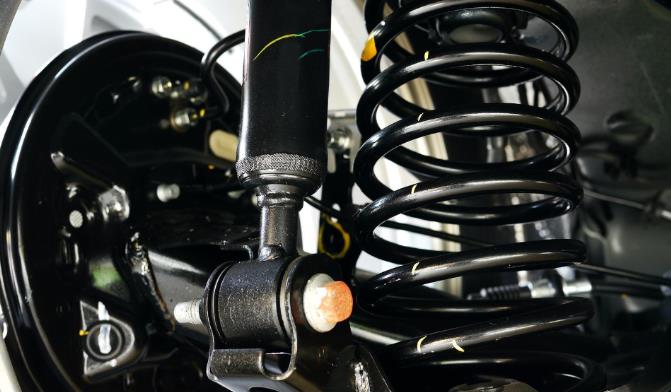
1. Hydraulic shock absorber.
This kind of shock absorber has been widely used in the early 20th century. It is generally a double-tube structure, also known as a compound-tube structure. Its advantages are that it has been developed for a long time, and the related technologies have been relatively mature and perfect. The cost is relatively low and it is easier to obtain damping. , Large stroke, belonging to the most widely used type of shock absorber in the vehicle suspension system; the disadvantage is that the heat dissipation of the double cylinder structure is worse than that of the single cylinder air pressure type, and the piston area is smaller than that of the single cylinder, so the maximum bearing capacity will be smaller .
2. Air pressure shock absorber
Compared with the traditional hydraulic shock absorber, the pneumatic shock absorber has one more gas chamber, which is generally filled with nitrogen inert gas. It is worth noting that the working medium of the pneumatic shock absorber is not all gas, the main cylinder is still oil, and only a part of the gas exists in the gas chamber. The traditional oil has a high viscosity and can provide efficient vibration damping effect, but the response speed is not fast enough. After the combination of oil and gas, it can fully make up for the weakness in the response speed and quickly achieve the shock absorption effect.
3. Electromagnetic shock absorber
The electromagnetic shock absorber is a kind of active shock absorber, which can obtain signals through the ECU of the vehicle, change the damping in real time, and control the rigidity and flexibility of the suspension. In theory, the ECU can control the electromagnetic shock absorber to change the damping within 1 second It is worth 1000 times, the shock absorption effect can be imagined, and of course the price will never be cheap.
As one of the main models in the logistics and transportation industry, the trailer's suspension must meet the standard strength while providing shock absorption performance.
In general, ordinary trailers can choose leaf spring non-independent suspension, which has strong reliability, low price and convenient maintenance;
Standard-load transportation that has higher requirements on cargo damage or is more sensitive to vehicle weight can choose air-type non-independent suspension, which has light weight and good shock absorption effect;
Trailers that often run heavy loads can also choose a single-point non-independent suspension, which has a stronger bearing capacity than ordinary leaf spring suspensions;
If the owner has a sufficient budget and high requirements for the suspension, in addition to less cargo damage, light weight, and good shock absorption, it also requires stability, bearing capacity, and a longer maintenance cycle. You can also choose an oil-pneumatic suspension, which can realize air suspension The shock absorption effect of the frame can also take into account the bearing capacity and the use requirements of complex road conditions.
